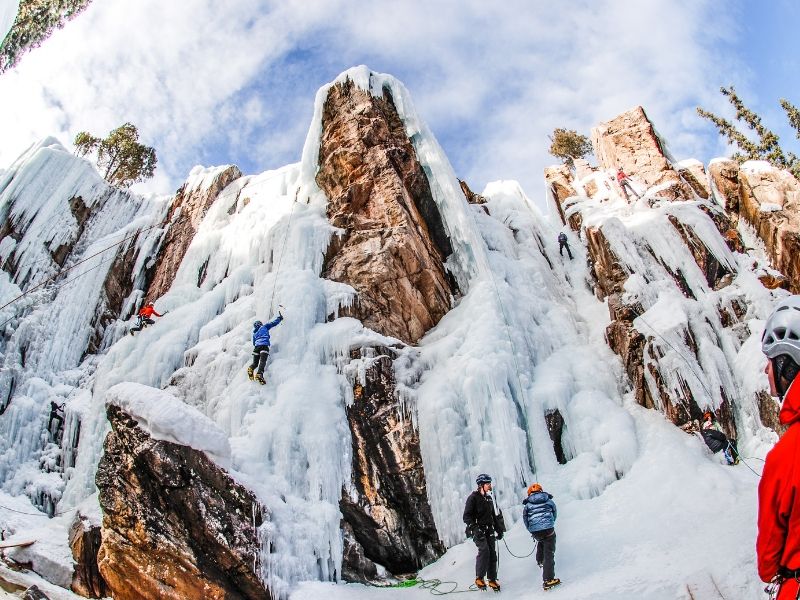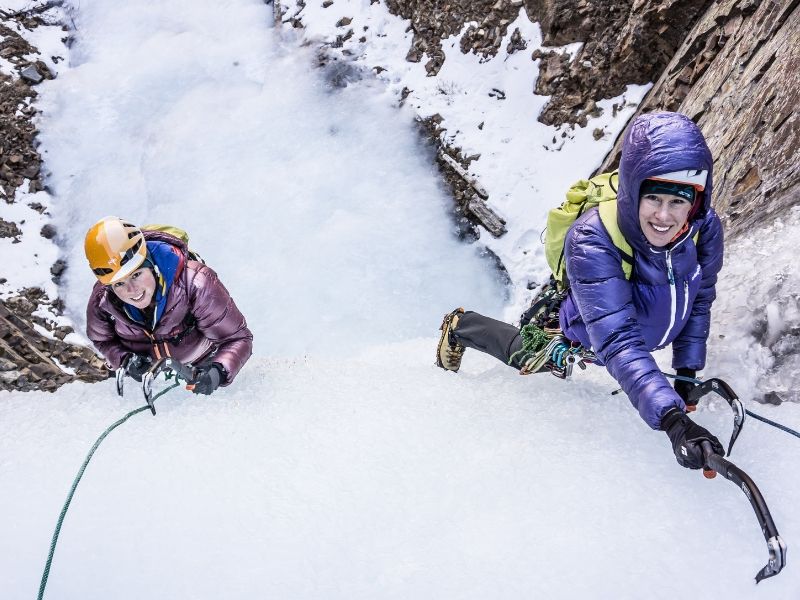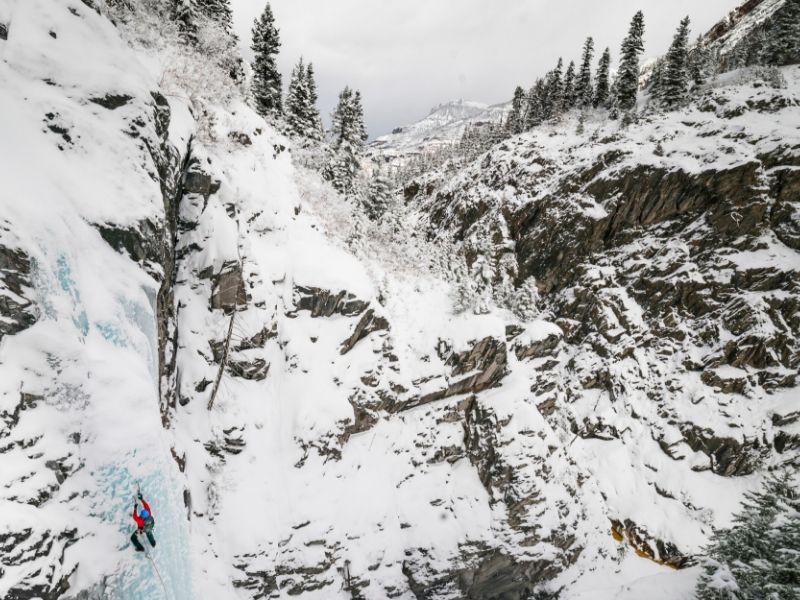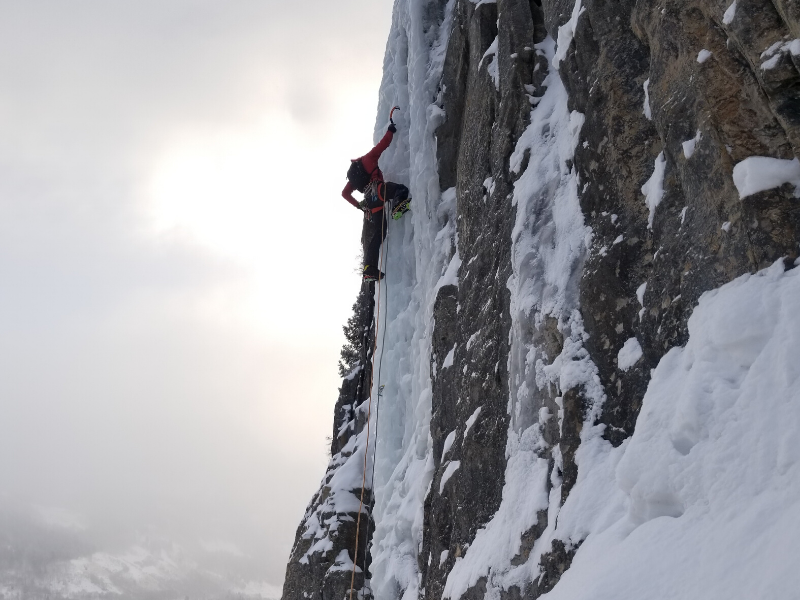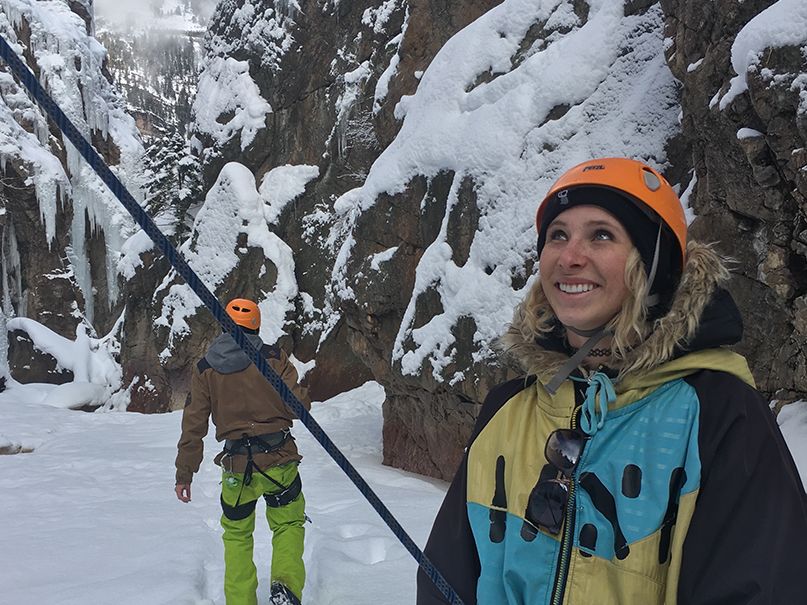Guided Ice Climbing in Ouray and the Surrounding San Juan Mountains
Ice climbing in Ouray, Colorado and the surrounding San Juan Mountains is simply spectacular! With the world famous Ouray Ice Park, legendary backcountry climbs, and remarkable, sunny weather, ice climbing in Ouray is both amazing and convenient.
Hire a guide who specializes in helping you progress
Progression is at the root of climbing. Climbing with the right guide can rapidly accelerate your progress as a climber. We specialize in meeting people where they are serving in the role of partner/mentor.
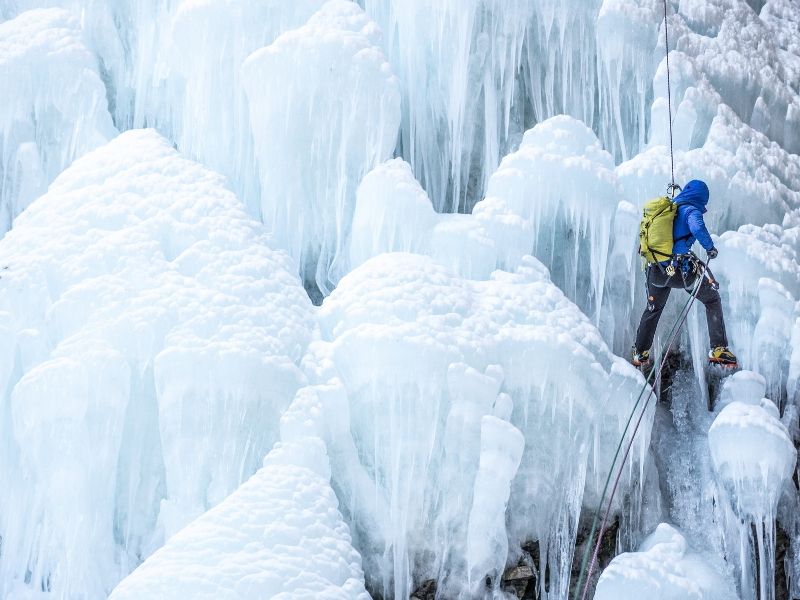
What Type of Trip?
Whether you are going climbing for the first time or live in your van, we have an option that will fit you.
Private Booking
Many days we book are private days where it’s just you and the guide. These can be half or full days or one or many days. This format allows us to tailor the trip perfectly to you.
Courses
We’ve distilled the most useful information into our series of courses. You’ll learn through hands on instruction from instructors who are masters of the climbing skills they are teaching.
Best 4 Days in Ouray
Do you have more than a weekend to spend in one of North America’s best ice climbing venues? The Best Four Days in Ouray is an itinerary intended for the climber interested in a proper sampling of the ice climbing of southwest Colorado.
Places We Guide
Climbing is an amazing vehicle to travel and experience new places. Come see the world from up here.
Ouray Ice Park
Whether you’re a beginner looking to try ice climbing for the first time or someone who is trying to break into the next grade, the Ice Park has something for everyone. We offer half-day, full-day, and multi-day programs in the Ouray Ice Park.
Backcountry Ice Climbing
In addition to the Ice Park, there are dozens of excellent destination-worthy ice climbs in the area. We offer guided ascents of dozens of climbs within a short drive of Ouray.
Ice Climbing Courses
Our course progression is designed around a simple principle: give participants the skills they need to get out there on their own.
Featured Media
Getting Started Ice Climbing
Getting started ice climbing can be intimidating. There’s a lot of equipment, a lot of risk, and a lot of required skill. Fortunately, there are a few ways to get started, and hopefully, our attempt to “address” the basics is helpful to you.
For more content like this subscribe to Peak Mountain Guides on YouTube.
Learning the Ropes
You can typically find ice climbers on frozen waterfalls…which are naturally occurring all over the world! There are also a handful of human-made ice climbing routes, such as the ones found in the world-famous Ouray Ice Park. These are created by faucets at the top of a canyon that are turned on when temperatures reach freezing. Water trickles down the canyon walls and freezes overnight to create massive walls and pillars of ice to climb. Climbers use crampons and ice tools to swing & stick into the formations and climb to the top.
Seasons
As you would probably imagine, the winter months provide prime conditions for ice climbing (mid-December to mid-March). The cold temperatures at night allow water to freeze, and sunny day time temps melt snow/ice to build upon/re-establish the route.
Grades
For seasonal waterfall ice, we use the acronym “WI”. Depending on the angle of the climb and overall difficulty of the route, we associate a number with the acronym. For example, routes with a consistent 60-degree angle (considered low angle) and occasional bulges/obstacles would fall under a WI2 grade. Something that is dead vertical (maybe slightly overhanging) with highly technical ice would fall under WI6. Knowing the grade of the route you are climbing is very important to ensure you don’t get yourself into a bad situation.
What to wear?
Dressing in warm, waterproof, functional clothing is an essential part of a successful ice climbing experience. Not having the proper gloves or jacket can result in a miserable day of climbing. Watch this video for what to wear ice climbing.
Gear.
Harness & Helmet
If you rock climb, you probably have these two things. You can use the same harness & helmet for ice climbing as long as they fit over bulkier clothing (snow pants & warm hat). If you don’t already have this equipment and are buying it specifically for ice climbing, check out harnesses with gear loops and ice clipper slots. The color, leg adjustment type, and padding are all personal preference.
Mountaineering Boots
Ice climbing requires a special kind of boot. These are typically insulated mountaineering boots. They have a rigid sole that keeps the boot sturdy when you thrust your foot into ice. There’s a lot to consider when buying a mountaineering boot. What material do you want? How stiff do you want it? Is it compatible with my specific crampon? Is it stylish?
Crampons
Crampons are basically metal spikes you attach to the bottom of your mountaineering boots and serve an essential purpose in ice climbing. You kick the front points of the crampon into the ice and “step-up” like you would on stairs or a ladder. Having graceful, precise footwork is a very important skill in ice climbing. You cannot “edge” like you would with rock climbing shoes. Some quick tips & common mistakes about crampons:
- Try not to kick repeatedly to set the crampon points. Kicking too hard is not only tiring but can weaken the ice you’re standing on. You learn quickly enough about “dinner plates,” or big flakes of ice that come crashing out when you’re too rough with tools or crampons.
- Another tendency is to keep one’s heels up too high, allowing the front points to pop out. Lowering your heels leverages the front points farther into the ice and will help to avoid an unnecessary slip. This is especially important at the end of a steep section or a pitch that ends on a shelf or on flatter terrain.
Ice Tools
Ice climbers always carry two ice tools while climbing. Ice tools are different from ice axes in that they are shorter than 60cm (24in). Anything longer than this will not be effective in technical ice climbing. They also have a more ergonomic (curved) shaft than an ice axe, and typically have a hammer on the head to help drive in ice screws.
- When placing your tools, look for depressions in the ice, which are stronger than outward bulges and resist fracturing a bit better. If you are following, look for holes left by your partner and place your tools in them.
- Just as with crampon placement, a single sure swing is far better than several taps or random chops at the ice. It saves energy and the ice surface. The right amount of force is important, too. Avoid swinging your tools too hard, or you will tire out your arms quickly. The more you can align your shoulder, wrist, and tool when you swing, the more direct and secure the placement will be.
- To remove your tools as you climb past them, lift them out the way they went in. Move the pick back and forth in the same direction it went into the ice, and push up on the adze or hammer to help lift it out. Try not to wiggle the pick side to side as this can break it.
How do you know it’s safe?
It’s not.
But there’s a difference between steep, technical terrain & low-angle, stable ice with limited overhead hazard. Choosing terrain that matches where you’re at in ice climbing is a great way to mitigate risk.
A knowledgeable, local guide adds immeasurable value to any mountain activity. Given that ice climbing is an extreme sport, the presence of a seasoned guide is also important for safety reasons. Climbers need to be aware of freezing temperatures, unpredictable weather patterns, and potential avalanches and crevasses. It’s also important to be able to read ice conditions. How do you know if ice is safe to climb on? We highly recommend taking at least one lesson before you go out climbing on your own. Peak Mountain Guides is located conveniently in the ice climbing mecca of the U.S., Ouray, CO! Our guides are stoked to get out ice climbing and would love to meet you where you’re at in your climbing journey. Whether you’re brand new and looking to learn & apply the basics, or you’re a seasoned ice climber looking for your next big adventure. We are the service to look to in the San Juans.
Contact Us
Mountain Trip
135 W Colorado Ave 2A | Telluride, C0 81435
